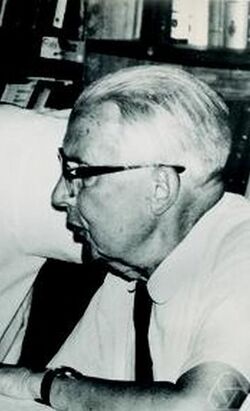Biography:Einar Hille
Einar Hille | |
|---|---|
 MFO 1971 | |
| Born | Carl Einar Hille 28 June 1894 New York City , United States |
| Died | 12 February 1980 (aged 85) La Jolla, California |
| Alma mater | University of Stockholm |
| Known for | Abstract differential equation Bohnenblust–Hille inequality Hardy–Hille formula Hille–Yosida theorem |
| Scientific career | |
| Fields | Mathematics |
| Institutions | Yale University |
| Doctoral advisor | Marcel Riesz |
| Doctoral students | Evelyn Boyd Granville Cassius Ionescu-Tulcea George Maltese Eugene P. Northrop Thomas L. Saaty Irving Segal |
Carl Einar Hille (28 June 1894 – 12 February 1980) was an American mathematics professor and scholar. Hille authored or coauthored twelve mathematical books and a number of mathematical papers.[1]
Early life and education
Hille was born in New York City . His parents were both immigrants from Sweden who separated before his birth. His father, Carl August Heuman, was a civil engineer. He was brought up by his mother, Edla Eckman, who took the surname Hille. When Einar was two years old, he and his mother returned to Stockholm. Hille spent the next 24 years of his life in Sweden, returning to the United States when he was 26 years old. Hille entered the University of Stockholm in 1911. Hille was awarded his first degree in mathematics in 1913 and the equivalent of a master's degree in the following year. He received a Ph.D. from Stockholm in 1918 for a doctoral dissertation entitled Some Problems Concerning Spherical Harmonics.[2]
Career
In 1919 Hille was awarded the Mittag-Leffler Prize and was given the right to teach at the University of Stockholm. He subsequently taught at Harvard University, Princeton University, Stanford University and the University of Chicago. In 1933, he became an endowed professor on mathematics in the Graduate School of Yale University, retiring in 1962.[3]
Hille's main work was on integral equations, differential equations, special functions, Dirichlet series and Fourier series. Later in his career his interests turned more towards functional analysis. His name persists among others in the Hille–Yosida theorem. Hille was a member of the London Mathematical Society and the Circolo Matematico di Palermo. Hille served as president of the American Mathematical Society (1947–48) and was the Society's Colloquium lecturer in 1944. He received many honours including election to the United States National Academy of Sciences (1953) and the Swedish Royal Academy of Sciences. He was awarded by Sweden with the Order of the Polar Star. [4]
Personal life
File:Stormer Hille Walsh Giambelli Fjeldstad Gonseth Polya Hille Mordell Riesz Fejer Wilkosz Stormer Lovenskiold Bohr Brouwer Zurich1932.tif Hille was married to Kirsti Ore Hille (1906–2001) in 1937, sister of Norwegian mathematician Øystein Ore. They had two sons, Harald and Bertil Hille.[5]
Works
- with Ralph Phillips: Functional Analysis and Semi-Groups. 1948,[6] 1957.
- Analytic Function Theory. 2 vols., 1959,[7] 1964.
- Analysis. 2 vols., 1964, 1966.
- Lectures on Ordinary Differential Equations. 1969.
- Methods in Classical and Functional Analysis. 1972.
- Ordinary Differential Equations in the Complex Domain. 1976.[8]
- In Retrospect. Mathematical Intelligencer, Vol.3, 1980/81, No.1, pp. 3–13.
References
- ↑ "Einar Carl Hille". School of Mathematics and Statistics, University of St Andrews, Scotland. July 2000. http://www-history.mcs.st-andrews.ac.uk/Biographies/Hille.html.
- ↑ Ralph Phillips (1994). "Einar Hille, Biographical Memoir". National Academy of Sciences. http://www.nasonline.org/publications/biographical-memoirs/memoir-pdfs/hille-einar.pdf.
- ↑ Einar Hille. National Academies Press. Biographical Memoirs V.63. 1994. doi:10.17226/4560. ISBN 978-0-309-04976-4. http://www.nap.edu/read/4560/chapter/12#220. Retrieved January 15, 2016.
- ↑ Hakan Hedenmalm. "Gösta Mittag-Leffler: A Man of Conviction". Royal Institute of Technology, Stockholm. https://people.kth.se/~haakanh/publications/stubhaug-ml.pdf.
- ↑ Bertil Hille. "Bertil Hille". Society for Neuroscience. https://www.sfn.org/~/media/SfN/Documents/TheHistoryofNeuroscience/Volume%207/c4.ashx.
- ↑ Bochner, Salomon (1949). "Review: Functional analysis and semi-groups, by Einar Hille". Bull. Amer. Math. Soc. 55 (5): 528–533. doi:10.1090/s0002-9904-1949-09226-1. https://www.ams.org/journals/bull/1949-55-05/S0002-9904-1949-09226-1/.
- ↑ Johnson, Guy (1960). "Review: Analytic function theory, vol. 1, by Einar Hille". Bull. Amer. Math. Soc. 66 (4): 253–255. doi:10.1090/s0002-9904-1960-10444-2. https://www.ams.org/journals/bull/1960-66-04/S0002-9904-1960-10444-2/.
- ↑ Sibuya, Yasutaka (1977). "Review: Ordinary differential equations in the complex domain, by Einar Hille". Bull. Amer. Math. Soc. 83 (5): 935–939. doi:10.1090/s0002-9904-1977-14328-0. https://www.ams.org/journals/bull/1977-83-05/S0002-9904-1977-14328-0/.
Other sources
- Dunford, Nelson (1981). "Einar Hille (June 28, 1894—February 12, 1980)". Bull. Amer. Math. Soc. (N.S.) 4 (3): 303–319. doi:10.1090/s0273-0979-1981-14895-3.
- Yosida, K. (1981). "Some aspects of E. Hille's contributions to semigroup theory". Integral Equations Operator Theory 4 (3): 311–329. doi:10.1007/BF01697968.
- Benson, Adolph B.; Hedin, Naboth (1969). Swedes In America. New York: Haskel House.
External links
- O'Connor, John J.; Robertson, Edmund F., "Einar Hille", MacTutor History of Mathematics archive, University of St Andrews, http://www-history.mcs.st-andrews.ac.uk/Biographies/Hille.html.
 |

